






Andrew Roff, Assistant Principal - IB Coordinator
In my last article for Patana News in January, I discussed how summative assessments, which evaluate learning at the end of a period, are changing. Over the next decade, we will move from paper-based to digital exams that better meet our learners’ needs. In this article, I want to focus on formative assessments, which are ongoing assessments used during learning to provide feedback and improve understanding. Formative assessments are more important because, unlike summative assessments, they focus on enabling development (quick Thai lesson: Patana means Development). I believe that the only summative assessments for Patana students are their final (I)GCSE and IB Exams. Everything else is formative.
There are many contemporary thinkers on the topic of formative assessment from Sir Dave Brailsford (Head of British Cycling and Team Sky) who popularised the idea of marginal gains, to James Clear (Author of Atomic Habits) who discusses the potentially huge impact of focusing on small consistent habits, and Dylan Wiliam’s metaphor of the cook tasting the soup before the customer does. But for me our very own Brian Taylor (Vice-Principal Campus Technology) has put it best, formative assessment is the reframing of the idea of feed-back as feed-forward
The trial examinations that our Year 11 and 13 students had just completed when I last wrote exemplify formative assessment for our students as they prepare for their final (I)GCSE and IB Examinations. When I asked our Year 13 students to reflect on their trial exam process, I was delighted
that the response was overwhelming focused on feed-forward, showing an awareness of what they know and what they need to improve…
“The trial exams showed me my weak spots and what I need to work on to ace my final exams.”Muniza Parvaiz
“The trial exams helped me recognise what parts of either my knowledge, exam technique or revision were lacking allowing me to focus my revision for the finals.”Nathan Pasqualini
“The trial exams were a good way to get a feel for how the IB exams are going to work in May, they help you feel less stressed about the real exams.” - Claire Herslov
“I was able to develop my exam technique by practicing how to manage my time and choose the questions I want to answer under pressure.” - Meera Krishnan
The result of this reflection is enabling students to clearly articulate an action plan, one that is individualised to them, which will have maximum impact on their results, when they receive them on July 6th (for Year 13). Action plans which draw on characteristics and strategies of excellent formative assessment. The notion of cramming (trying to remember a large amount of material in a short period, usually right before a test) for example, which let’s be honest we have all done, has been comprehensively discredited as an effective tool for exam performance and real-world knowledge. Daniel Willingham (2009), a cog-
nitive scientist, argues that cramming leads to superficial understanding and rapid forgetting. Certainly not traits which will serve our learners well. Far more effective, and valuable for our students is to emphasise the efficacy of well researched techniques such as:
•Spaced practise - which strengthens memory retention and understanding by allowing time for forgetting and relearning.
•Interleaving - different topics or skills are mixed together rather than practising one at a time. This approach forces the brain to constantly retrieve and apply different types of information, making learning more flexible and durable.
•Self-testing - actively retrieving information from memory rather than just re-reading or passively reviewing material. This technique strengthens long-term retention and helps identify gaps in knowledge. (Bjork and Bjork, 2011)
These are things our team of dedicated teachers do at every level of our school as part of their daily teaching routines. They are also techniques for enabling effective differentiation, taking the teacher from the traditional role of ‘Sage on the Stage’ to becoming the ‘Meddler in the Middle’ (McWilliam, 2009) and empowering our students to personalise their learning journeys, supported by embracing the ever-improving AI tools which are available to us.
Assessment should not be feared or cause anxiety; instead, it should be seen as a valuable tool for learning and growth. Assessment does not equal examination. Assessment is an on-going and essential element of
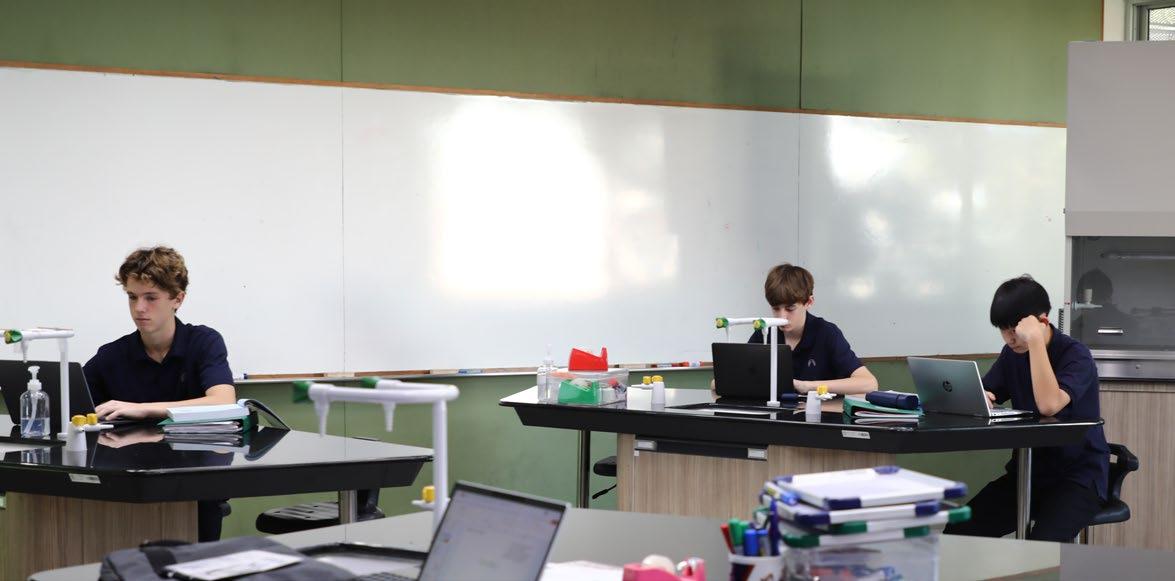

good learning and teaching. It is an essential component of everything we do, all the time, every day. It is the information that allows the feed-forward to happen, and improvements (learning) to take place. Assessment should be celebrated, embraced and privileged (although marking can still a bit of a pain!)
Bjork, E.L. and Bjork, R.A. (2011). Making things hard on yourself, but in a good way: Creating desirable difficulties to enhance learning. In: Gernsbacher, Pew and Pomer -
antz, eds., Psychology and the real world: Essays illustrating fundamental contributions to society. New York: Worth, pp.59–68.
Black, P., Harrison, C. and Lee, C. (2014). Working Inside the Black Box Assessment for Learning in the Classroom. Learning Sciences Intl Llc.
Clear, J. (2018). Atomic Habits: An Easy & Proven Way to Build Good Habits & Break Bad Ones. New York: Penguin Publishing Group.
Education Scotland (2016). Dylan Wiliam: Formative assessment. YouTube. Available at: https://www.youtube.com/watch?v=sYdVe5O7KBE
McWilliam, E. (2009). Teaching for creativity: from sage to guide to meddler. Asia Pacific Journal of Education, 29(3), pp.281–293. doi:https://doi. rg/10.1080/02188790903092787.
Willingham, D.T. (2009). Why don’t students like school? : a cognitive scientist answers questions about how the mind works and what it means for the classroom. San Francisco, Ca: Jossey-Bass.
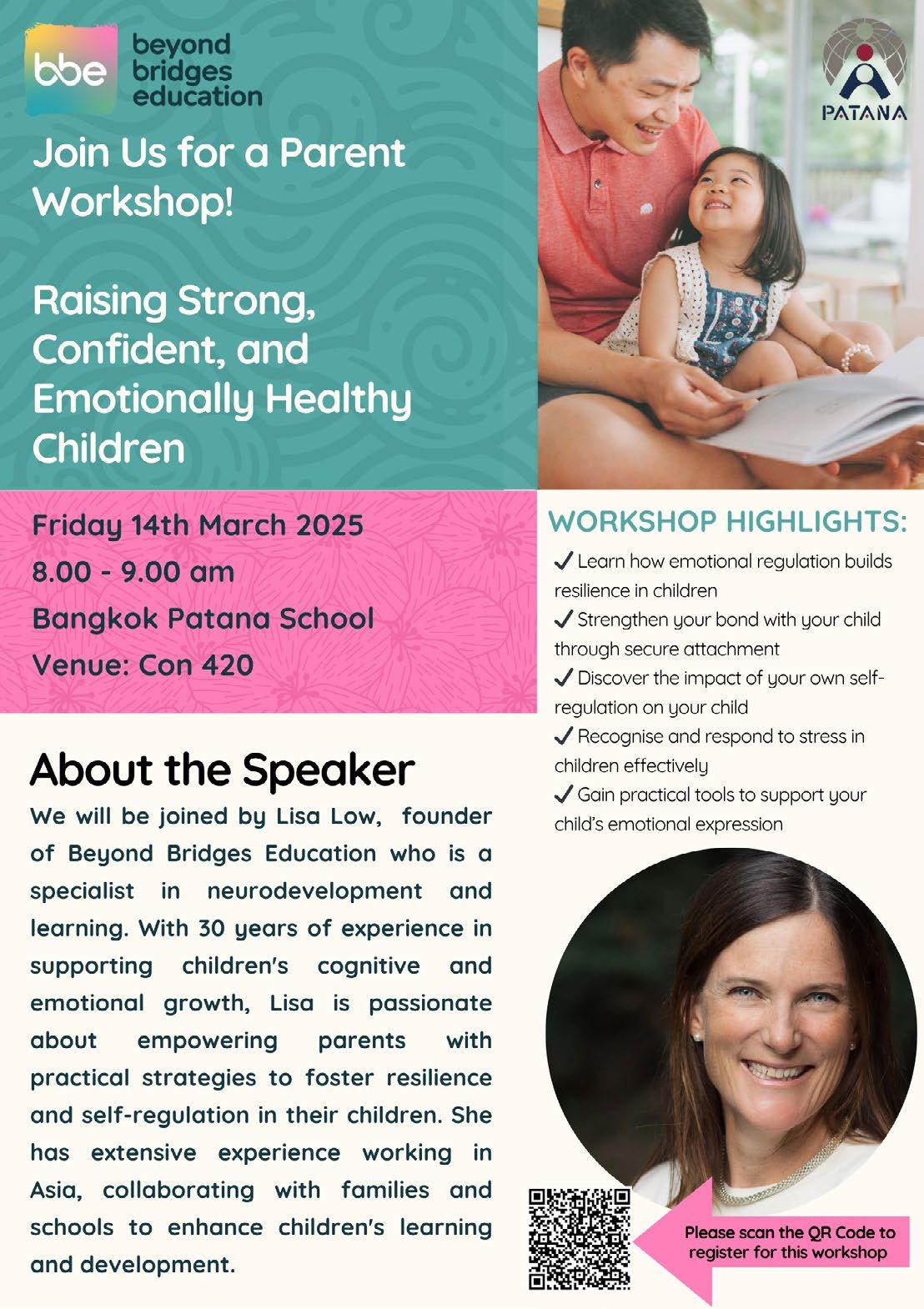
Carol Battram, Vice Principal, Pastoral
Children need accurate information about their body, how to keep themselves safe, and how to build healthy and positive relationships at many different points in their life.
If you would like to hear more about how and what we teach your child as part of our PSHE curriculum (Personal, Social, Health Education), please join us at a parent presentation and sign up via the links below. All presentations start at 8 a.m. in the Primary Hall.
Tuesday 11th March – Audience: Year 1, Year 2 and Year 3 parents and carers - LINK
Tuesday 18th March – Audience: Year 4 and Year 5 parents and carers - LINK
Tuesday 25th March – Audience: Year 6 parents and carers - LINK
At home, talking with your child about relationships, their body, and how to keep themselves safe, works best as an ongoing conversation. Most children are curious about relationships and sex and would like to know more. Asking and answering questions helps children develop understanding. If you aren’t sure how much they already know, ask them some questions back. If they ask a question at the wrong moment - promise to talk about it later and keep your promise.
Children need to learn about their body, and how their body will change over time. Your child needs to know the right words for all parts of their body. As a family, you may have other names for genitalia and other ‘private parts’ and that’s fine. At school, we teach the names of their private parts (vulva, testicles, bottom/buttocks, nipples and penis), in the same way that we name other body parts (elbow, knee, toes). We teach that some parts should be kept private, and introduce Talking Pants to help keep them safe.
Interests and needs change with age - you may recognise some of these behaviours from different points in your child’s development.
• Your child only wants to play with the same friend
• Your child only plays with friends of the same biological sex
• Their games often include relationship role-play
• They comment on body changes
• They ask you - repeatedly - how babies are made
• They are curious about differences between boys and girls
• They don’t think about being naked
• They would be embarrassed to be seen naked
• They would be very embarrassed to see you naked
• They find it hard to separate from you
• They want to spend less time with you and more time with friends
• You now get a grunt instead of a farewell hug
Below is a rough guide to the ages at which children show interest in their body, develop a sense of privacy and experience physical changes as they move through school.
Infancy: Up to two years
Toddlers can start to learn names for all visible parts of the body, including private parts.
They may start to show curiosity about physical differences.
Age appropriate consent should be part of these conversations, so that all children can recognise when a touch is safe and welcome - and when it is not.

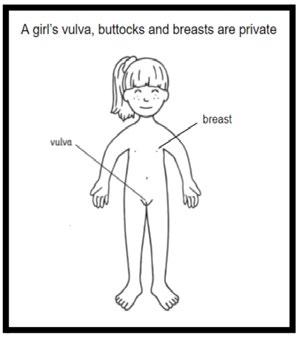
https://www.themamabeareffect.org/shop/sku00175-body-safety-communication-cards-451
Children are taught that their body belongs to them.
They have a right to privacy - for example, when going

to the toilet.
They can be shown how to say no when they don’t want to be touched.
They are taught that we do not show or share parts of our body covered by underwear or swimwear, and that nobody has the right to touch their private parts. They will be taught what to do, what to say, and who to tell if they ever feel unsafe or unsure about a touch.

Children recognise that we all change and grow in different ways.
They develop their understanding of consent, privacy and respect for others.
They are interested in the different ways in which babies are made and born.
They learn that some families look like theirs and some look different.
They learn that every family belongs in our school.
Children need to know about puberty before these big changes occur.
It should not be a mystery.
Some will start puberty earlier than their friends and some much later.
We teach girls about boys’ changes, and we teach boys about girls’ changes.
Boys need to know about involuntary erections and wet dreams, so that they know what to expect. Girls need to know about periods and how to access sanitary products.
We continue to help all students develop their understanding of what makes a relationship healthy and positive, including consent, safety and respect.
Your child may start to challenge the status quo within the family.
They may experience significant and complex upsets within their friendship group.
All of this is normal - but that doesn’t make it any easier for them, or for you.
Your child will need age-appropriate and trusted information at different stages of their physical, sexual and emotional development. Please be realistic about the possibility that your child may either seek out or be shown content not produced or marketed for children. It’s infinitely preferable to find books or other sources of information that you feel comfortable sharing with your child.
Not every child wants to talk to their family about puberty, sex and relationships - but a book can be a bridge to conversation and shared curiosity. Search online bookstores or visit our excellent libraries and ask for recommendations. I’ve flagged some old favourites here, but there are now so many great books to share with your child - or to nonchalantly leave lying around your home.



Joseph Denton, Head of Swim Academy

FOBISIA SWIMMING 2025 (DIVISION 1)
75 TigerSharks entered FOBISIA, which took place at Rugby School Thailand. The meet saw an impressive 403 personal best performances across 468 events, a massive 86% personal best percentage! These performances saw the TigerSharks claim the following awards: Team Awards:
•9-10 Age Group Combined - 2nd place
•11-12 Age Group Combined - 1st place
•Junior Age Groups - 1st place
Top 3 Individual Age Group Scores
Swimmer Age Group Placement
Yaya T. 9yr Girls 3rd Place
Clay S. 10yr Boys 1st Place
Anuree M. 11yr Girls 2nd Place
Katie C. 12yr Girls 3rd Place
Congratulations to our following TigerSharks on breaking school records at FOBISIA Swimming 2025:
Swimmer Event
Katie C. (11-12 Girls)
Relays: Relay Team Event Time Swimmers
Girls 9-10
2:15.00 Nisa B., Audrey T., Kaosuay B., Yaya T. Boys
Clay S., Nico M., Morris F., Hugo T. Girls
Katie C., Chloe C., Anuree M., Chloe L.
F., Hugo T., Clay S., Nico M.
It was an amazing weekend of racing at RST from our TigerSharks, congratulations to all on their individual performances. Thank you to our orange army parents, for making the journey down and supporting the team on poolside!
20 of our Senior TigerSharks took part in SEASAC at NIST this weekend. It was an incredible three days of fast racing from all teams, with our TigerSharks firmly in the mix throughout the 15-team conference meet.
The Girls’ were in the thick of a tough battle throughout the three days and took home a strong 4th place, with only 20 points separating 2nd-5th in the final standings.
The Boys were predicted to finish 4th prior to racing, they battled hard throughout, chasing down the team in 3rd. It came down to the last relay of the meet, with Boys’ Captain Leo A. producing the fastest relay swim in TigerSharks history to bring the Boys’ home in 3rd place in the final standings.
Congratulations to our TigerSharks on claiming medals at this year’s SEASAC Swimming 2025:
Swimmer Event
Emma E. Girls 50 Butterfly
Emma E. Girls 100 Butterfly
Leo A. Boys 50 Freestyle
Leo A. Boys 200 Freestyle
Leo A. Boys 100 Backstroke
Relay Medalists:
Relay Team Event
Girls 200
Medley Relay Panna N., Kelli C., Emma E., Jasmine M.
Boys 200
Medley Relay Loch VG., Michael B., Tiger T., Leo A. 3rd Place
Boys 200
Freestyle Relay Michael B., Tanwaar T., Loch VG., Leo A.
Boys 400
Freestyle Relay Loch VG., Michael B., Tanwaar T., Leo A.
With fast racing at SEASAC brought some school records for our TigerSharks swimmers!
Swimmer Event Time
Emma E. (1314 Girls) 50 Butterfly 29.07
100 Butterfly 1:06.22
Leo A. (15/ Over Boys) 50 Freestyle 23.86
Congratulations to all our TigerSharks who represented the team at SEASAC, demonstrating our 3 pillars of humility, diversity and passion throughout.
Thank you to our orange army parent community who cheered loud and proud on poolside this weekend, making it feel like a home meet for our TigerSharks!


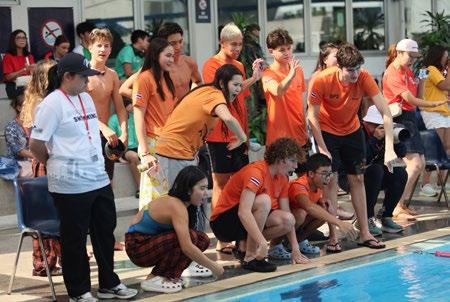
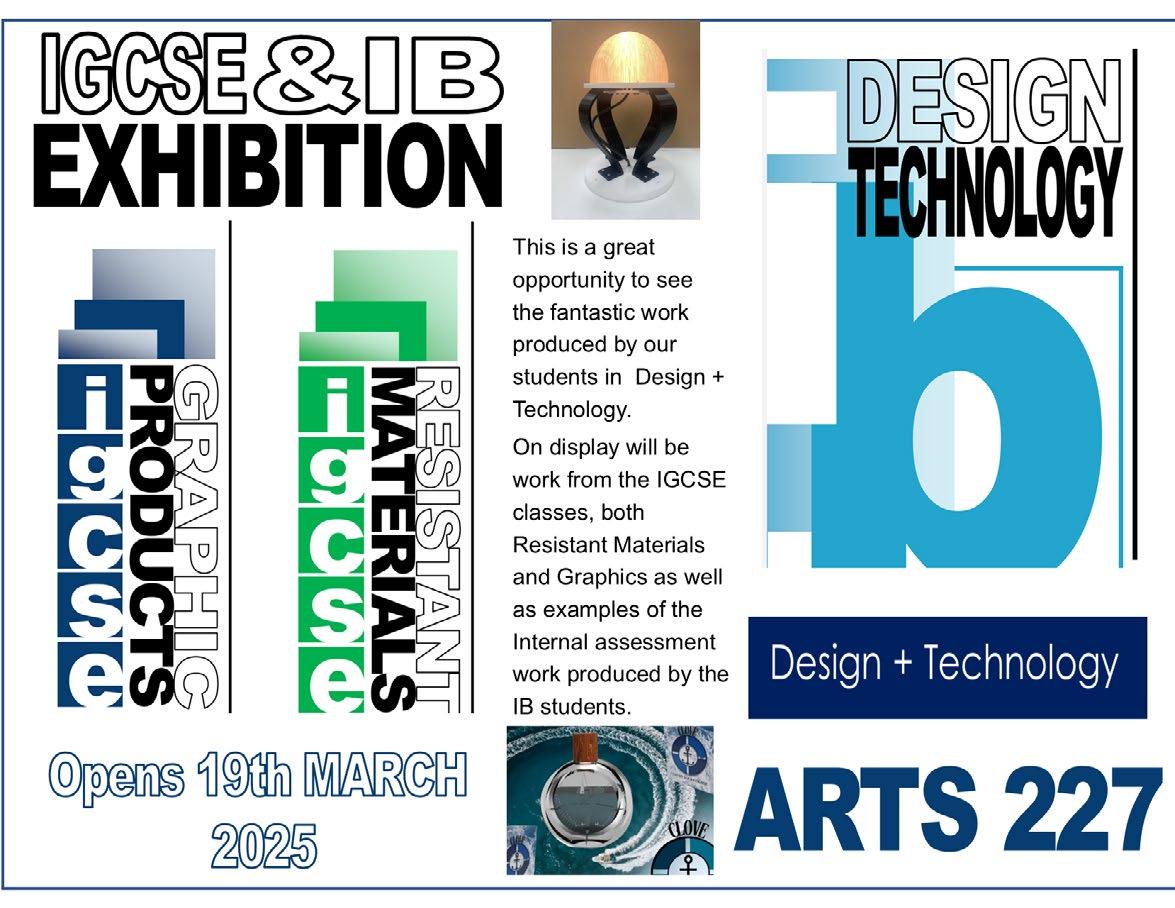
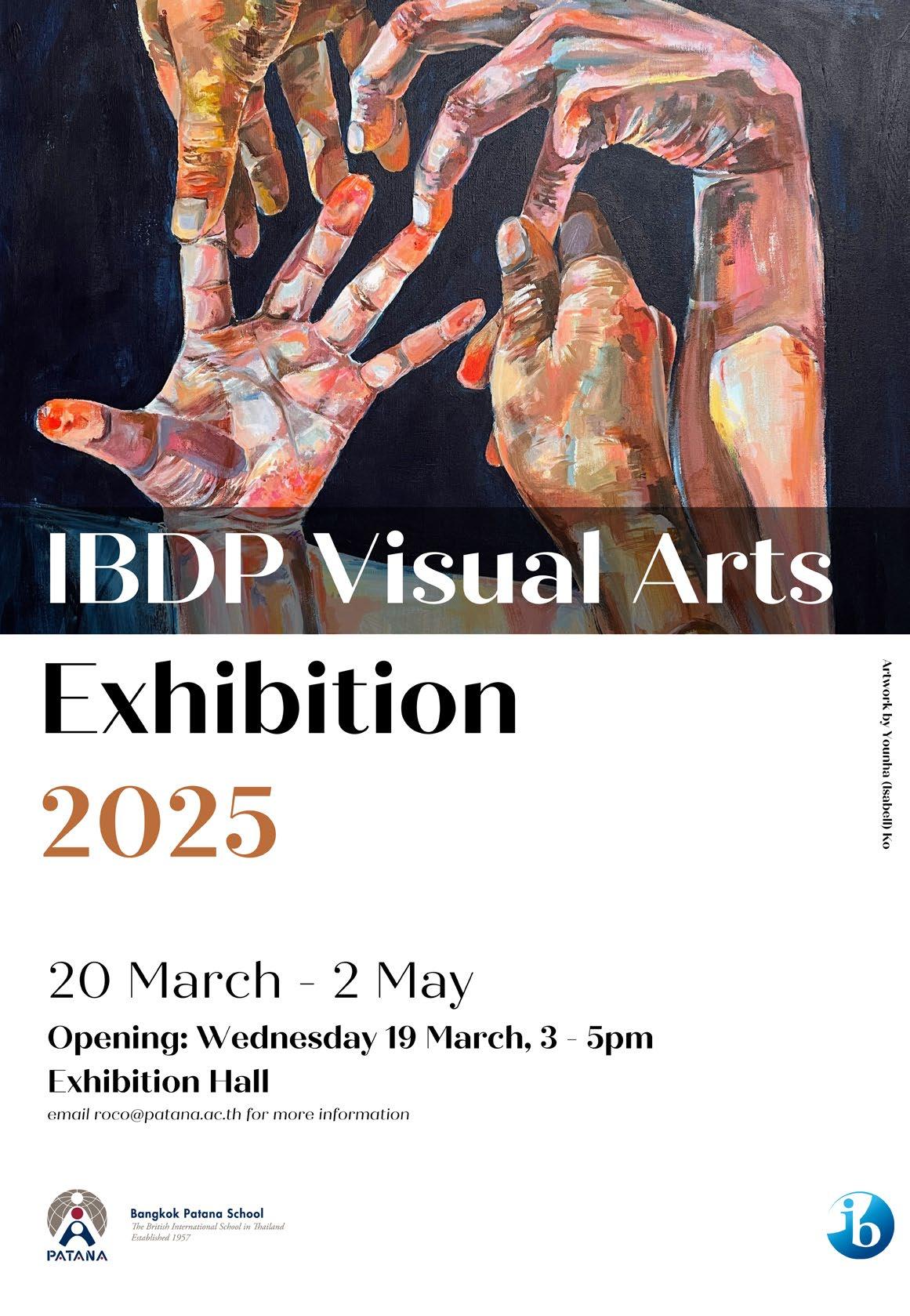
John Clare, Design + Technology Teacher
Over the course of Year 12 and 13, our Design + Technology students have taken multiple trips to The Village International Education Centre as part of their Internal Assessment and undertaken their own design project, focusing on socially responsible design. We make four visits to The Village throughout the project, with each visit demonstrating the fantastic work our students have done here at Patana, developing their investigation and initial ideas to fully functioning working prototypes.

Angelina has worked extremely hard in developing an education toy that not only encourages students with autism to engage with water based play but teaches scientific principles on precipitation. The prototype has undertaken many different iterations, following the design process from concept to final testing and refinement, all the way through to commercial production. The outcome of this project is a fantastic example of empathetic design.
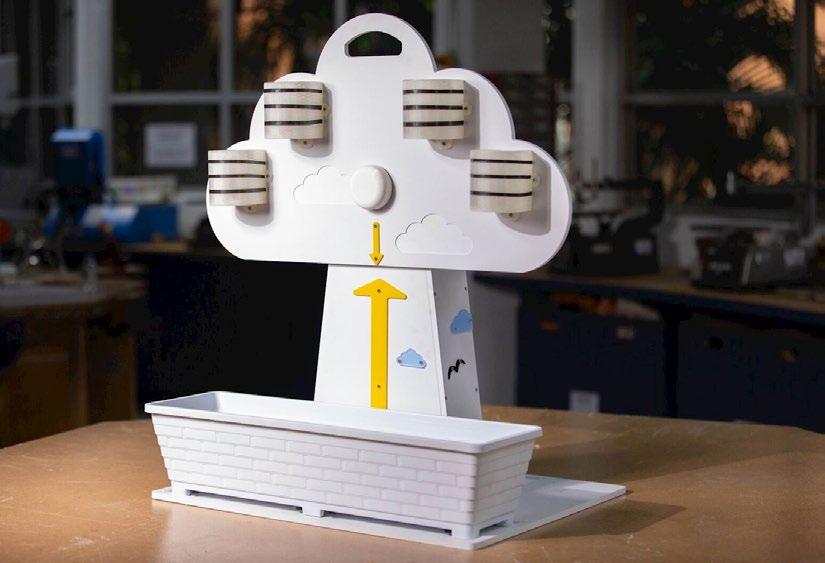
Throughout this project, I collaborated closely with autistic students and experts from The Village International School to design a sensory toy tailored to their developmental and sensory needs. The primary goal was to create an engaging resource that encourages sensory exploration while supporting the development of fine motor skills, an essential skill for daily life.
To refine the product, I made several prototypes, testing different colors, sizes, and heights to ensure the toy was accessible and suited to their needs and anthropometric
profile, improving the ergonomics of the design.
The final design draws inspiration from the concept of rain falling from a cloud, adding a whimsical touch to appeal to younger students. The toy mimics patterns of rain, allowing children to practice fine motor skills by pouring water into them while learning about balance and scales, with the goal to get the cups to balance. The cups also have small holes at the bottom, creating a calming sensory experience as water flows through, blending learning and play.
Peam has focused his design skills on developing a learning aid that stems from his observations at The Village. Peam took an existing concept and focused his energy on improving what is now a tired practice. Combining a teaching strategy of scaffolding the learning for students, taking large sweeping motions into finely tuned pieces of writing, through the process of modelling and repetition, building student confidence and independence.


Throughout this project, I partnered with The Village International Education Centre and a team of experts to design a product specifically aimed at supporting individuals with challenges in gross motor skills.
The objective was to create a prototype that effectively promotes the development of gross and fine motor skills. By closely collaborating with the school’s teachers and students, I conducted multiple testing phases and gathered invaluable feedback, which played a pivotal role in refining different iterations of the design.
This educational resource seamlessly integrates cognitive stimulation with physical activity, focusing on essential skills for everyday life. The result is an engaging and accessible learning experience that is carefully tailored to meet the diverse needs of the students. The success of the project was evident in the positive feedback from both staff and students, highlighting it’s effectiveness in enhancing motor skills and engaging learners in a meaningful way.

Initially, the thought of taking a gap year filled me with apprehension. I worried about falling behind while my friends embarked on their university journeys across the globe. Stereotypes of gap years as aimless or detrimental to future studies clouded my judgment, leaving me uncertain.
Yet, despite its uncommon nature in this region and the skepticism surrounding it, a structured gap year can be profoundly transformative— broadening horizons, offering handson experiences beyond academia, and providing clarity in choosing a degree with greater maturity.
Now that I’m halfway through, my initial fears could not have been further from the truth.
After discussing the prospect with my university counselor, teachers, and family, I realized the wealth of opportunities a gap year could offer— through work, travel, and personal
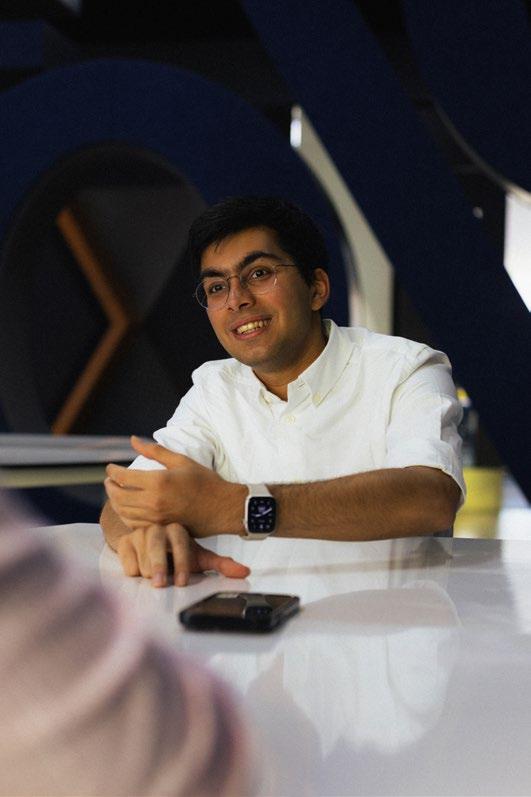
growth. Upon graduating in May, I spent months carefully organizing work experiences and travel plans, ensuring a clear sense of purpose. With a defined plan, I embraced the unorthodox path.
I first worked at the Thai Prime Minister’s Office, assisting in policy development by researching global issues. My work focused on reforming and rebranding Thai National Television and proposing microfinance reforms. This experience deepened my understanding of policy implementation and allowed me to contribute fresh, forward-thinking ideas.
I then transitioned to the Finance Ministry, continuing research-driven work on global welfare systems and proposing innovative welfare reforms. I also contributed to Thailand’s Entertainment Complex Project, developing comprehensive justifications for its advancement.

Beyond politics, I have been actively involved with Inspiring Girls, a non-profit organization. I helped organize events in public schools, empowering students to explore a diverse range of career opportunities beyond conventional pathways. This experience has been especially fulfilling, allowing me to express my passion for education reform in new and meaningful ways.
Six months ago, I could never have imagined the breadth of experiences I would gain—the people I would meet, the impact I would make, and the real-world insights I would develop. Six months from now, I will enter university with a richer perspective, professional experience, and a pragmatic understanding of Philosophy, Politics, and Economics (PPE).
So don’t dismiss a gap year—it might just be the perfect path for you!

1. Order Display and Envelope Distribution: From March 10, 2025, Sunshine Photo will set up displays and envelopes will be distributed to all students and staff.
2. Order Submission Deadline: Please ensure all orders are submitted by March 24, 2025
3. Expected Delivery Date: We anticipate delivering the orders by the end of May 2025
For any questions or assistance, please contact Marketing at publications@patana.ac.th

Yixuan Low, Year 12
WeHearU is a student-led community engagement club that helps raise awareness about hearing disabilities and audism. We work alongside the Setsatian School for the Deaf to raise funds for hearing aids and surgeries that help to improve their hearing. This academic year, we visited the school twice, with the first visit helping us to understand the school’s needs. On the second trip, we delivered a series of art activities to the children, helping us to form bonds with them and the school as well as empathise. Now we aim to raise 50,000 baht to help fund hearing aids and batteries for the hearing aid for the younger students in the school.
In addition, WeHearU have been working on a new project that we hope to make available for the school and students by the end of this academic year: Silent Pathways. We want to create more opportunities for deaf students after they graduate by providing a career-related programme for the students. We hope to do this by using surveys and working with career development groups. Another key aspect of the WeHearU club is raising awareness. At WeHearU, we are committed to fostering awareness and understanding of hearing impairments within our school community. By educating others about
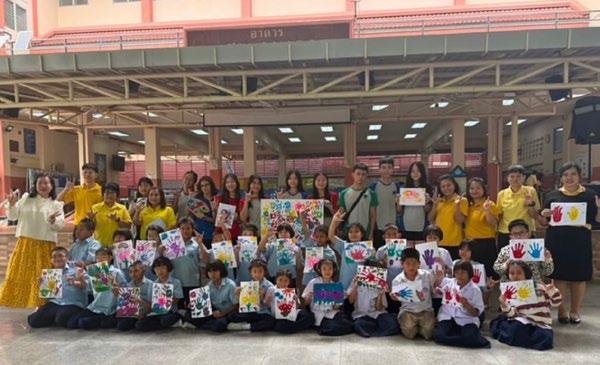

the challenges faced by those with hearing loss, we aim to create a more inclusive and supportive environment. Through advocacy, fundraising, and outreach, we want to make a meaningful impact and ensure that everyone has the opportunity to be heard.
This academic year, WeHearU has been very active in school events, helping to raise funds and increase awareness for our cause through our participation in the Fun Run, community week bake sale, and the Grease concert. We are thankful for the support of the students, teachers, and parents in Patana, who donated and helped us on our journey to reach our monetary and club goals of helping the deaf society in Thailand. Our next event is Dunk Tank @ Fun Day, which will be held on the 8th of March. Come join us and get dunked!
Lastly, we are incredibly grateful for the dedication and passion of our members and board members, whose efforts help raise awareness and support for individuals with hearing disabilities and have got us one step closer to our objective. We hope that the person reading hears us and wants to help support our cause. You can follow us on Instagram @wehearu_bps
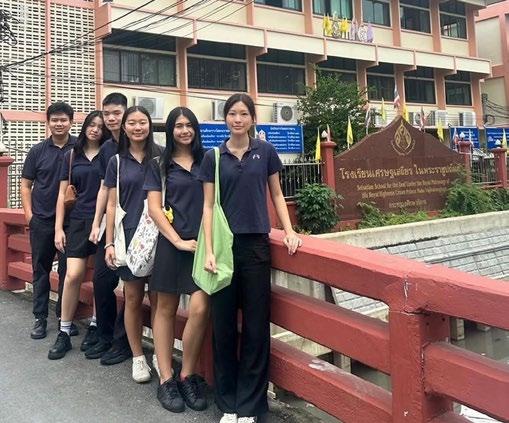
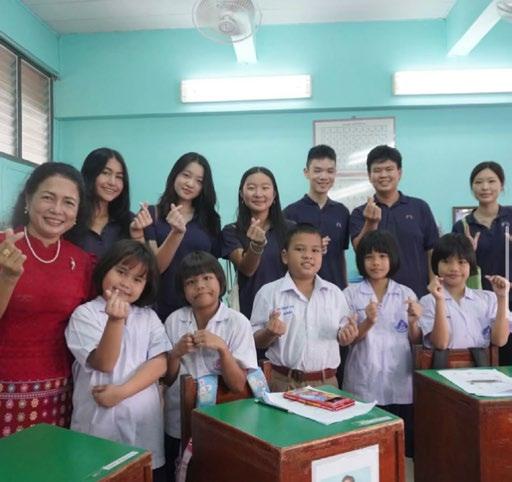
Cindy Adair, Cross Campus Principal

It’stime to announce and introduce our first two Eco Heroes for the calendar year!
Our January winners were the BPS Economist Community Engagement Team and in particular their United Wardrobe Project. This project focuses on fighting fast fashion by encouraging a circular economy. The group ask us to bring in old lightly used clothing, it is then washed and packed for distribution to those in need, or to be sold in their pop-up thrift store. The team also aim to educate the next generation and have offered workshops to Year 4, 5 and 6 students about ways they can fight fashion. So if you have clothing you’d like to donate, look no further. United Wardrobe Project have collection bins at the front of school and have also recently expanded to several other schools in the city.
Our February winners hail from the Business side of our

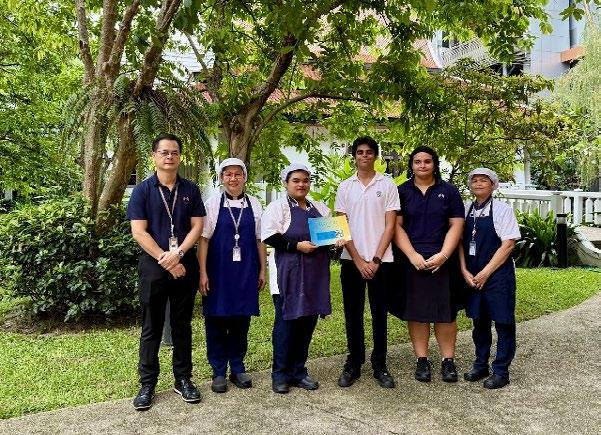
school – the hardworking Food Services team! Not only have they worked tirelessly to reduce the amount of single use plastic used in our Snack Bar packing, they are also actively looking to expand dishes with a low carbon footprint. Dishes which are predominantly plant based, use local and seasonal produce and consume less water during the growing process. During Waste Less Week 10, they worked directly with students to create signature #wastelessweek10 dishes such as a Green Smoothie, Green Acai Bowl and a delicious Tofu Based Kaho Soi noodle bowl. On top of that the Food Services team ensure minimal food waste via their partnership with Scholars for Sustenance, a wonderful charity which collects unused food and distributes to those in need.
Congratulations to both of these groups and thank you for your efforts to build a more sustainable Patana! Who will be our March Eco Hero? Could it be you?


Nada, 7U
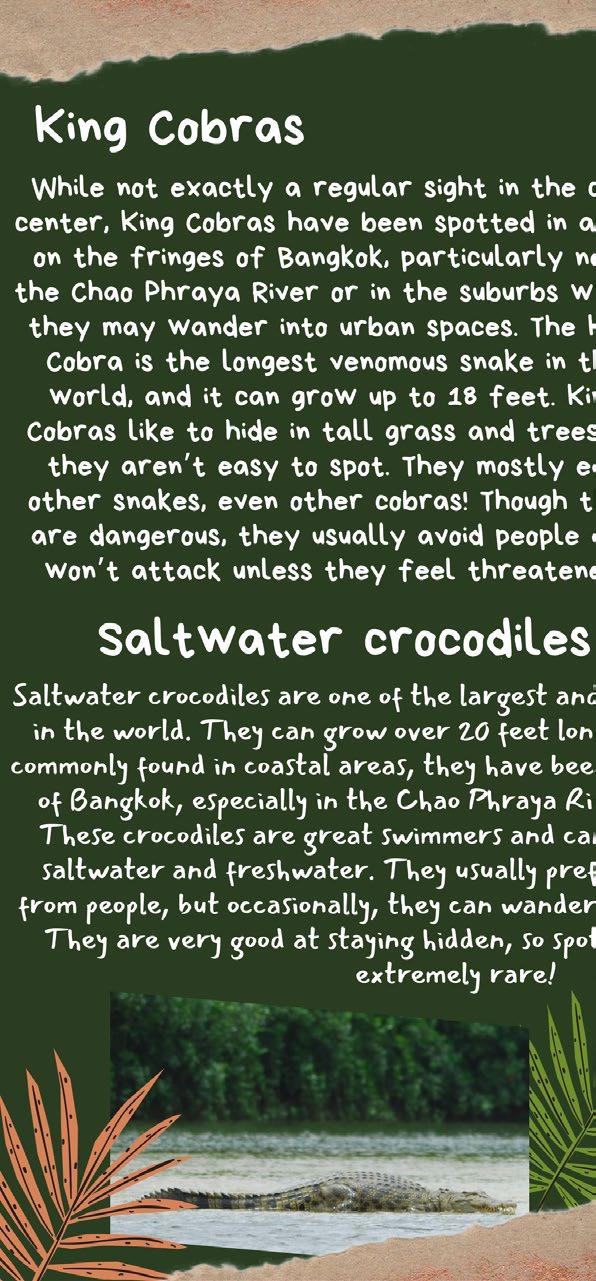
In the Word Is Out! ECA, Key Stage 3 students get to write articles about what interests us. I chose to write about wildlife because ever since I was young I was intrigued about wildlife and animals. I always loved when my parents would take me to the zoo and show me rare species of animals that I had never seen before. This article is about animals, which you may not expect to find, living in Bangkok!

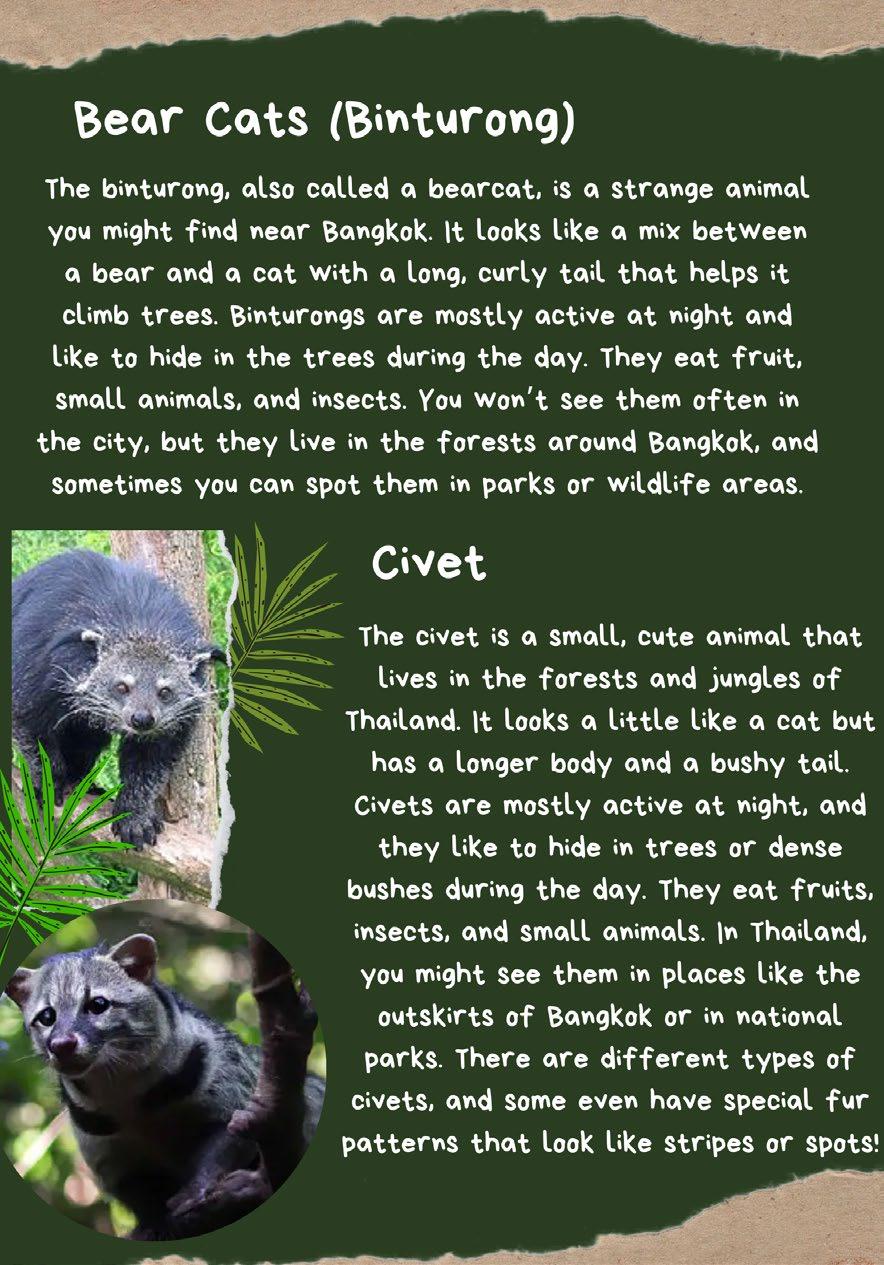

The Gulf of Thailand became a classroom for twenty students last weekend as the PMCG embarked on their trip to Pattaya. Split into different groups, students developed their skills as scuba divers and took part in conservation programs that reflected our school’s commitment to sustainability and environmental responsibility.
Seven students successfully completed their RAID Open Water certification during the trip, marking the beginning of their journey as qualified scuba divers. Under the guidance of instructors from Thai Ocean Academy, these students mastered essential diving skills while experiencing the underwater world for the first time.
“It was fun and amazing, we are so happy to have our scuba diving licences at such a young age,” said Ellina Partridge and Mariah Zeng from Year 6. Amelie Jauncey, also from Year 6, added “I think more people should dive because, even though there are really cool creatures on land, there are even better ones under the ocean. It is educational and fun!”

The certification process included practical skills training, theory sessions and four open water dives, culminating in an achievement that opens doors to future marine conservation work, a lifetime of underwater exploration and awesome holidays!
A second group, comprising students with previous diving experience, focused on documenting marine biodiversity. They balanced lectures on board the boat, with guided dives to help them identify the fish, coral and invertebrates found in the Gulf of Thailand. The students encountered stingrays, pufferfish, nudibranchs and turtles – all just 90minutes drive from the font of school.
The course gave these students to experience the work of professional Marine Biologists. Filipa Silva from Year 12 said that “The EMP course was an incredible experience that deepened my knowledge of marine ecosystems and their habitats. It was thrilling to apply real scientific methods first hand in the field and see the importance of conservation efforts that are used by many.”
Year 12 student Kate Clare explained that “by doing the
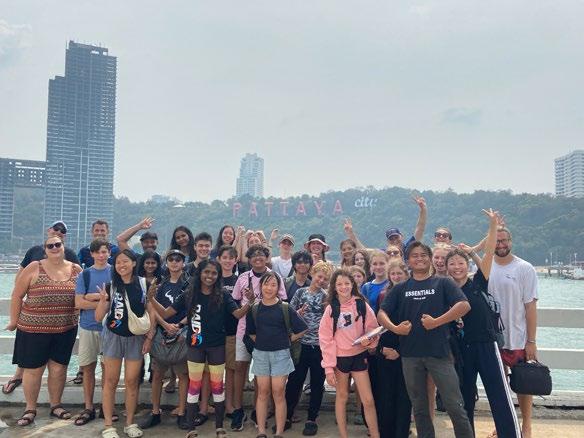
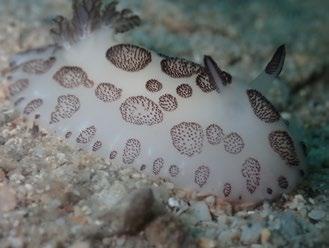

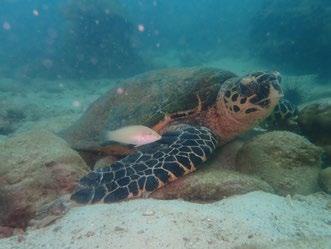
EMP course I was able to gain a deeper understanding of coral reef health through the species we found, as well as the distinguishing features of indicator fish species that show the health of a reef.” She recommended the trip to any students interested in marine conservation, adding that it was “very fun and you were able to make friends and work with new people!”
Perhaps the most rewarding role fell to the Cleanup team, who learnt to locate, record and carefully remove old fishing gear from the ocean floor. These discarded nets and lines continue to entangle and kill marine life long after being abandoned. The students followed a protocol developed by the Marine Science Citizens Initiative (MARsCI) which utilises citizen science to contribute to data collection on the location and quantity of derelict and discarded fishing gear in Thai waters. The focus and dedication of the students impressed both the supporting Bangkok Patana teachers, and the Thai Ocean staff.
“After seeing the incredible work these students are doing, we’re more committed than ever to supporting young conservationists,” says Adam Stoddard, lead instructor at Thai Ocean Academy. “Their enthusiasm and determination give me hope for the future of our oceans.”
Year 13 student Kaira Kothari added, “It was such a memorable experience, a good note to end my PMCG journey on!”
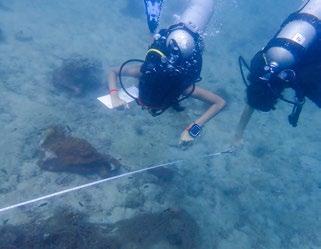
“What makes this program special is the progression pathway it offers,” says PMCG coordinator and Head of Year 10 Miss Brown. “Students can join as complete beginners and gradually develop into skilled conservation divers making a tangible difference to marine ecosystems.”
The PMCG welcomes Secondary students with any level of experience, offering after-school sessions, and the opportunity to participate in school-led dive trips.
For younger enthusiasts, the Tiger Tails Marine Conservation ECA provides Years 5-8 students with age-appropriate Marine Conservation sessions, as well as the opportunity to experience scuba diving during a ‘try dive’ pool day.
The partnership with Thai Ocean Academy continues to grow, with the dive company offering a special “try dive” experience during the school’s upcoming Fun Day on March 8th. This supervised session in the school pool will offer students a taste of scuba diving without committing to a full certification course.
Students interested in joining the PMCG can contact Miss Brown (yvbr@patana.ac.th). No previous experience is required – just a willingness to learn and a passion for protecting our marine environments. Students can join the Tiger Tails Marine Conversation ECA through the Block D sign-up process.
Richard Smith, Head of Design + Technology
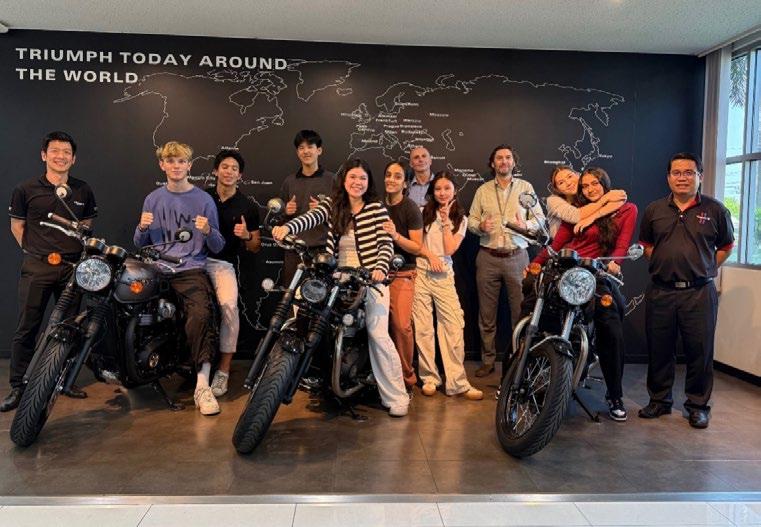
Aspart of the Design Technology IB course, every year we take our Y12 students on a visit to the Triumph Motorcycles Factory in Chonburi. The visit is an integral part of the course, reinforcing theoretical work covered while studying commercial manufacturing principles and raw materials to final product.
Here’s what our students think about their recent visit:
“As IB Design Technology (DT) students, we are currently designing our own individual products. Throughout this process, we have explored different materials, manufacturing techniques, and production methods. IB DT plays a crucial role in many industries, including business and engineering, as it helps to develop innovative, high-quality products. Understanding real-world applications of design and technology allows us to bridge the gap between theoretical learning and practical implementation.
We were honoured to have the opportunity to visit the Triumph factory, home to one of the world’s most renowned and beloved motorcycle brands. Founded in the UK in 1898, Triumph has a rich history of engineering excellence and innovation.
The factory tour provided us with a detailed look at the complex manufacturing and assembly processes involved in motorcycle production. Each component undergoes thorough inspection to ensure precision and quality. The factory is divided into different sections, each dedicated to a specific stage of production, where careful monitoring helps minimize errors and maintain high standards.
The trip to the Triumph factory was not only educational but also an incredibly enjoyable experience. Witnessing the production process firsthand was eye-opening. It gave us a much clearer understanding of how a product is designed, developed, and manufactured on an industrial scale. This experience further emphasised the importance of design and technology in creating high-quality products, inspiring us as we continue developing our own projects. We also gained valuable insights into how a multinational business leverages economies of scale to enhance efficiency and competitiveness in the global market. By observing the integration of automation alongside skilled labour on the production line, allowed us to have a deeper understanding of operational strategies within large scale manufacturing. Overall, it was a great experience, especially having the opportunity to personally speak with the operations director.” - Gui-Chai Tangchaiyawong
“I really enjoyed the visit to Triumph, especially the assembly section, where you could look closely into the process of building up a motorcycle from scratch. The combination of huge ranges of parts and materials getting put together, creating a monster of bike really took my interest and I would recommend exploring similar industrial experiences, as it also gave a great insight of how design and technology, works together with industry.” - Xander Uhre
“The trip to the Triumph factor was extremely enjoyable as an educational visit. It was very fulfilling and eye opening to see how motorbikes are manufactured and assembled in real life. The trip enabled us to learn about the production and manufacturing stages of creating a product, to a clearer degree.” - Cameron Chakrabandhu
“My visit to the triumph factory in Chonburi was very interesting and provided me with an interesting insight on how motorcycles are made at the factory.” - Mahi Italiiya
“I learnt a lot, especially how Triumph implemented and used visual stream mapping and lean production.” - Pun Pun Srivikorn

Courtesy of Talking to Kids About Tech – Media Mentor Month ’25 | Tip of the Iceberg
“This year’s Media Mentor Month 2025 eBook, Talking to Kids about Tech, addresses common pain points for parents—from managing screen time and online behaviour to handling difficult conversations about social media and digital privacy. It offers practical strategies to help make these conversations more productive, including sentence starters that guide parents and teachers toward more positive and collaborative dialogue. Strategies are organised by age of child, so parents can find the most relevant examples easily.
This resource was developed by a team of passionate educators. We invite you to explore this eBook, which we hope will be a helpful resource in making your conversations around technology more engaging and empowering. We look forward to continuing the conversation and expanding it to include voices from even more diverse backgrounds in the future.”

Have a great weekend.
Brian Taylor
Vice Principal, Technology for Learning


From observing the world through a camera lens as a young student to showcasing his photography in the TAPs exhibition, Noppanat (Warm) Poyu has transformed his passion into a creative journey. As Bangkok Patana’s Photographer and Marketing Coordinator, Warm’s latest exhibited collection at the inaugural ‘Patana Canvases’ is inspired by the urban landscapes he encountered on his daily commute. He presented his work in an exceptionally unique and strategic layout—a photographic collage— where each image contributes to the whole, creating a striking visual narrative. In this interview, he shares how his fascination with architecture, a leap of artistic courage, and the support of the TAPs CPL programme have shaped his work and future aspirations.
ROLE: PHOTOGRAPHER AND MARKETING COORDINATOR
1. Can you share the story of how your photography journey began, what initially sparked your interest in the craft, and how your career has evolved since then?
I began my photography journey in Mattayom 2 (around Year 7) using my uncle’s camera during a family trip. Fascinated by the numbers, text and shapes on the back of the Canon 550D, I asked my uncle if I could try
it. He taught me some basic photography techniques, and after taking my first photos, I realised my love for the craft.
I later graduated from Mae Fah Luang University with a degree in Hospitality Industry Management, specialising in hotels and resorts. After graduation, I worked for five years as a Marketing Communication and Media Creator before joining Bangkok Patana School as a School Photographer and Marketing Coordinator.
2. Your latest photography collection is inspired by your daily commute in Sathon. Can you share how these experiences shaped your creative process?
Before joining Patana, I spent two years working in the Sathon area, commuting daily by motorcycle. The frequent stops at traffic lights gave me time to observe my surroundings, especially the buildings. Seeing them at different times of the day—morning, noon, and night—offered unique perspectives that inspired me. In my mind, I began piecing together fragments of these structures, imagining how they might look combined in unexpected ways. This curiosity led me to create this photography collection, giving life to the question, “What would it look like?”.
3. What was your thought process behind choosing how to present your work in this exhibition?
For this exhibition, I chose art paper for printing as it’s ideal for showcasing photography in its best quality. The

process was straightforward, though I faced challenges with time management, having made my decision to participate quite late.
4. What motivated you to take part in the TAPs CPL programme, and how has it influenced your artistic journey?
Joining the TAPs CPL programme was a significant step for me. I’ve always dreamed of exhibiting my photography but lacked the courage to pursue it. This time, with immense support and encouragement from my team (Marketing team), I decided to take the leap. This experience has motivated me to continue creating. I plan to experiment with film photography in the future, potentially exploring new
themes while building on the techniques and ideas I’ve developed here.
5. The TAPs exhibition, ‘Patana Canvases,’ celebrates the artistic practices of our community. How do you see your work contributing to this theme and inspiring others to participate?
In connection with the exhibition theme, ‘Patana Canvases: Unveiling the Artistic Practices of Our Community,’ my work represents a bridge to future TAPs programmes. By showcasing diverse ideas and creative possibilities, I hope to inspire others in the community to join and share their artistic voices.
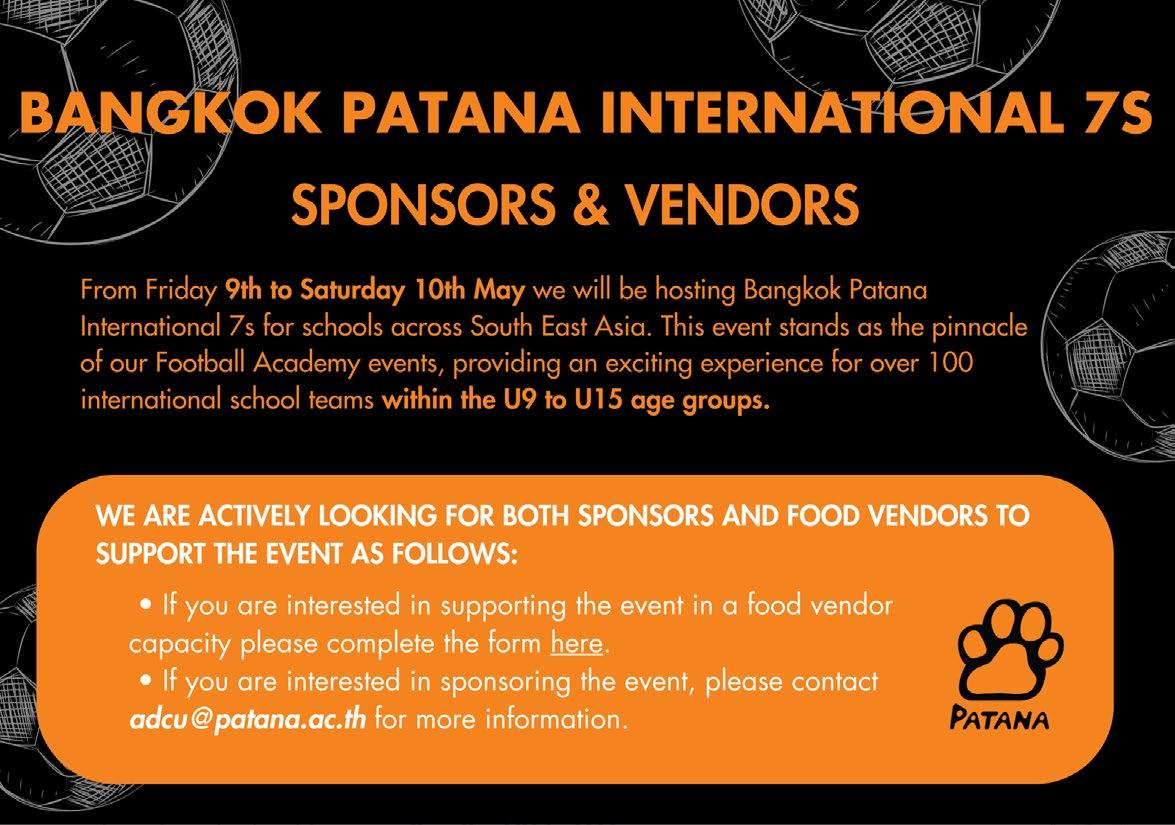
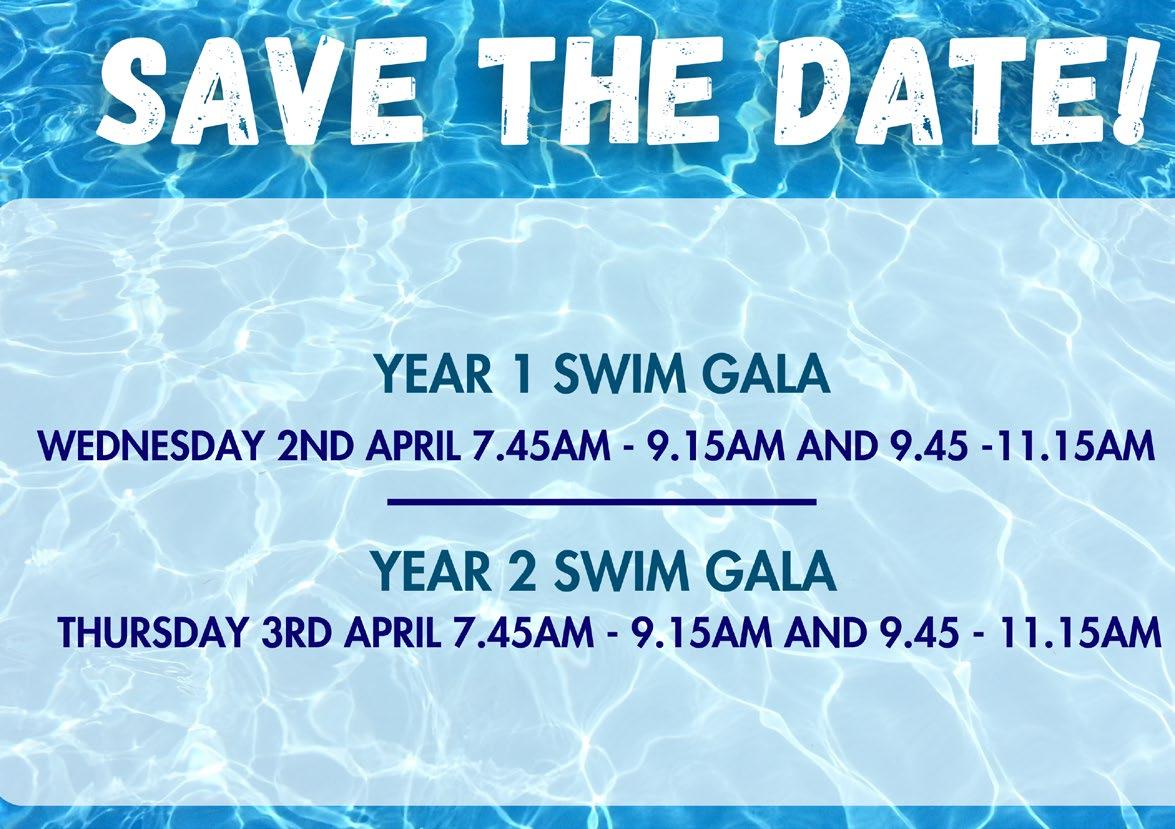
Rodney Fountain, History Teacher
The 2025 Thai National BMX Championships began last month in Sukhothai. This meant riders from all over Thailand descended on the classic ‘U in a U’ shaped track to see who could pilot their bike down the start hill, over the jumps, and around the berms faster than anyone else. All riders except Patana history teacher Rod Fountain (No.823), that is. He had to miss Round 1 because it’s a really, really long drive to the track and to make it there, race, and get back in a state fit to teach on Monday morning just isn’t possible. However, Round 2 was at the FBT track in Bangkok, which meant he was in the start gate for his fifth consecutive year of BMX racing in the master’s category. This is the category where the riders aged 50+ compete and as such there are more and more competitors who ‘end up’ there every year, to make up for the ones who might feel they’re getting too old for this kind of
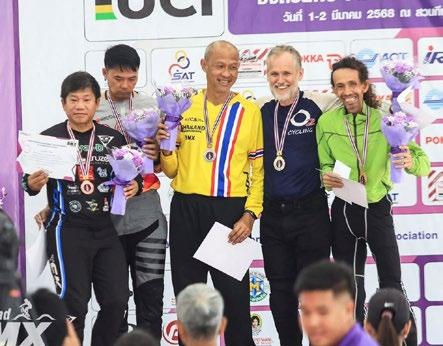
Nicole Lau for her outstanding performance in the U8 fencing category, securing the championship. We are also proud of parents Na and Georgia, who turned their interest in fencing into active participation, earning silver and bronze medals in the veteran category. We encourage more parents to join our fencing program.
racing! Held over an entire weekend, riders from aged 4 upwards compete in motos (heats) before the number is whittled down the fastest eight who compete in one final, 40 second race around the jump-strewn track. Rod had a good weekend, winning his heats and the final and so came into school beaming on Monday.
BMX racing is known for all sorts of things: drama, excitement (and yeah, crashes). That aside it’s known for being a family-oriented sport, and in the Thai race scene that’s particularly strong. In some families, everyone races but even if they don’t, whole families turn up to hang out and watch mum, dad, and the kids race. If you’d like to know more about this amazing scene, then look at facebook.com/pedalsreadygo or message Rod on rofo@ patana.ac.th It’s never too late, or too soon, to start this wild ride.

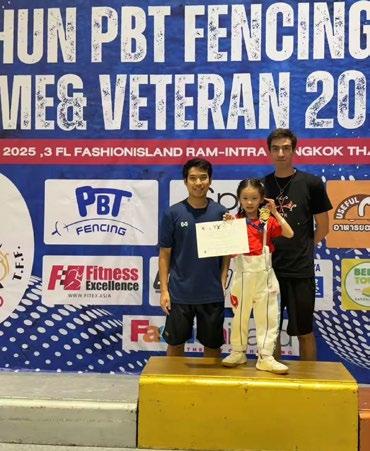
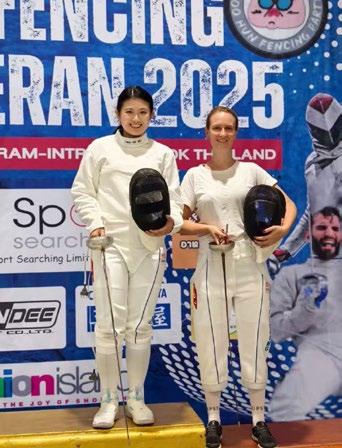
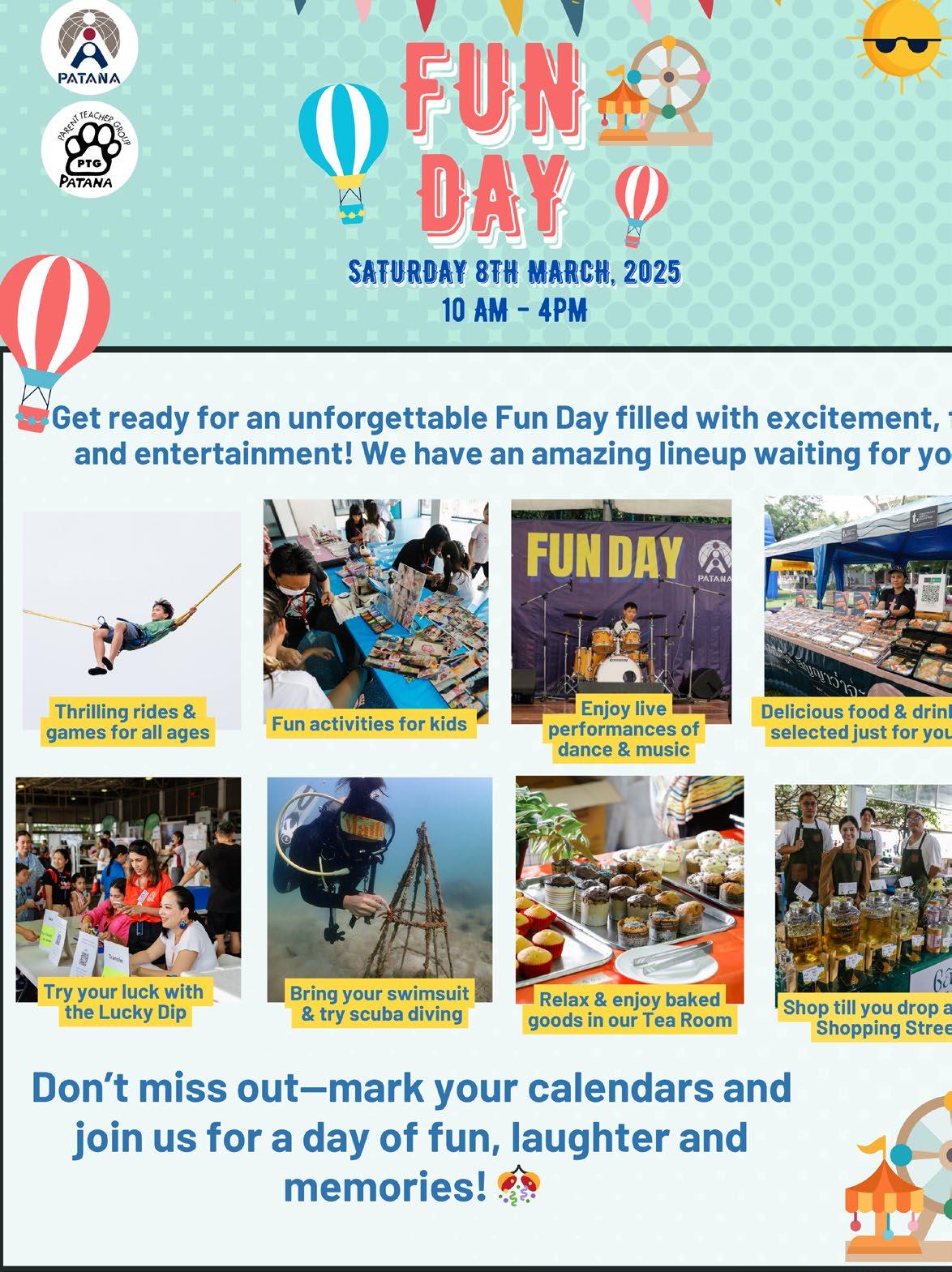




International Women’s Day
Children Saturday Storytime
8th March 2025
10:30am
Free for members, 200 Baht for non-members
Registration required. Book your spot here https://bit.ly/StoryTimeRegistration








